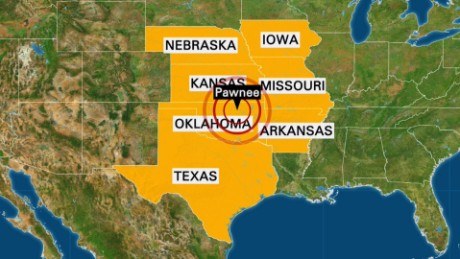Oklahoma earthquake was caused by environmental issues

The 5.6-magnitude earthquake located in Pawnee, OK was felt in seven states. Photo courtesy of cnn.com.
September 20, 2016
On September 3, an earthquake happened in Oklahoma. It impacted six states around it: Texas, Kansas, Arkansas, Missouri, Nebraska, and Iowa. It was a 5.8-magnitude earthquake; people felt early that morning. This earthquake was not because of the earth’s crust or landform like most earthquakes. It was more about environmental issues.
This earthquake spurred state regulators in Oklahoma to order 37 disposal wells, which are used by frackers, to shut down over a 725-square mile area. The quake that struck Saturday is at least the second of its size to affect central Oklahoma since 2011.
Based on new data, the Oklahoma Corporation Commission’s Oil and Gas Division (OGCD) is taking further action in the area of the 5.8-earthquake that occurred in the Pawnee area on September 3, 2016. The new data is the result of work by the Oklahoma Geological Survey and the United States Geological Survey.
The total size of the area of interest, or AOI is 1,116 square miles
The number of wells in the AOI is 48 Arbuckle disposal wells within the OCC jurisdiction and 19 Arbuckle disposal wells within the EPA jurisdiction. This means a total of 67 Arbuckle disposal wells.
32 wells have ceased operations: 27 in the OGCD jurisdiction and 5 in the EPA jurisdiction.
The total volume reduction is 40 thousand barrels a day in the OCC jurisdiction only.
Jeremy Boak, head of the Oklahoma Geological Survey, said it’s possible that a large “pulse” of disposed wastewater is slowly moving deep underground and triggered the temblor along the new fault located near the town of Pawnee, farther east than most of the previous earthquake activity in Oklahoma.
The water at issue is extracted from the ground along with oil and gas, separated and re-injected into deep wells. The 75,000 barrels a day of wastewater that was being injected in the area is being reduced to about 35,000 barrels a day, said Jim Marlatt with the oil and gas division of the Oklahoma Corporation Commission. Forcing oil and gas operators to stop injecting wastewater or to reduce the amount they can inject means they can’t produce as much oil and natural gas, which can cause a serious financial hardship, said Chad Warmington, president of the Oklahoma Oil and Gas Association.
Whether wastewater disposal from oil and gas production triggers earthquakes draws much attention. Although there has been a serious earthquakes before in Oklahoma, the government still needs to pay attention and take actions to deal with it.
Sources:
Earthquakes.ok.gov
http://abcnews.go.com
